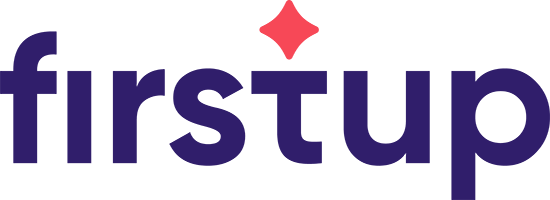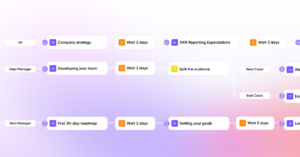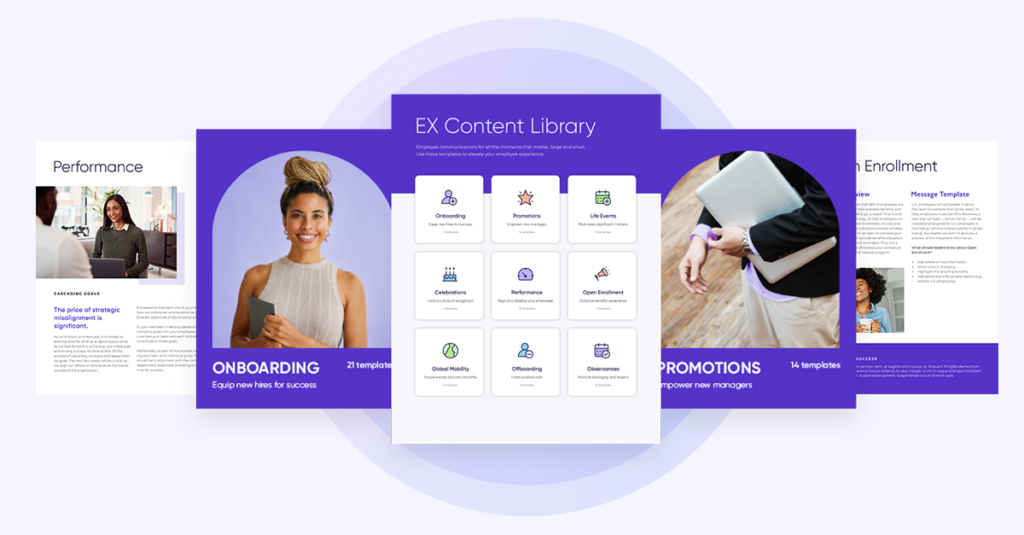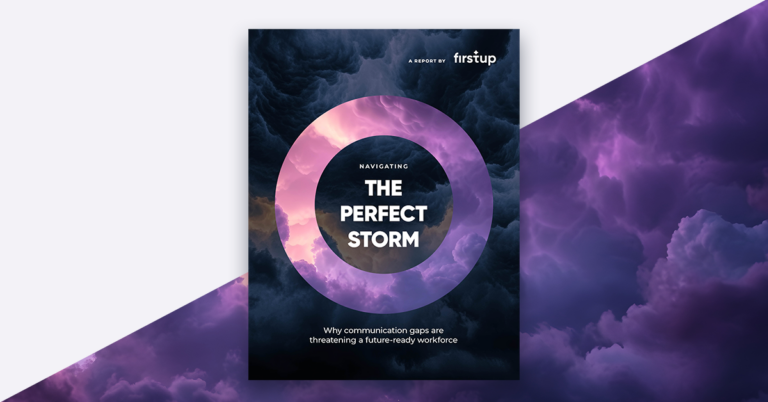If you want to build a company where employees feel excited to show up and do their best work, effective employee engagement has to be part of the plan. Employee engagement is really about the emotional connection and commitment your people have to your organization and what it stands for. When employees feel that connection, they tend to be more productive, experience higher job satisfaction, and are less likely to look for opportunities elsewhere.
This kind of employee engagement doesn’t just help with retention, though. It shows up in your customer experience, your team’s collaboration, and even your bottom line. A strong employee engagement strategy creates a positive work environment at the center of it all.
Want the full story on what employee engagement really means and the difference it can make? Take a look at our post on why employee engagement is the key to company success.
If you want to improve employee engagement, keep reading. These strategies can help you understand employee engagement and create a place where people are motivated, connected, and ready to make an impact.
Benefits of employee engagement

An effective employee engagement strategy matters because good intentions alone aren’t enough to keep people connected or committed. Even teams with a strong sense of purpose can lose momentum if daily frustrations build up or wins go unnoticed. A clear employee engagement strategy turns those good intentions into everyday actions and habits that help people feel appreciated, included, and experience greater job satisfaction.
When you put real thought into how to support and involve your team, you create a workplace where people can do their best work and want to stick around for the long haul.
How to develop and implement an employee engagement strategy
Most employee engagement strategy efforts fail because they’re built in conference rooms by people who don’t actually do the work. If you want yours to succeed, flip that approach.
Here’s an action plan for how to build an employee engagement strategy that actually works:
- Talk to your people first – Skip the formal employee engagement survey initially and have real conversations about what frustrates them and what keeps them motivated. What makes a good day versus a bad day? When do they feel most energized at work? What would make them consider leaving?
- Recognize that one size doesn’t fit all – These conversations will tell you more about employee engagement than any consultant report. You’ll discover that your sales team needs different things than your customer service team. Remote workers face different challenges than office-based employees.
- Involve employees in design – Let your managers help shape how recognition programs work. Ask employees what professional development opportunities would actually be useful to them. When people help build the strategy, they don’t just comply with it. They champion it.
- Set measurable goals – Define what success looks like within the organization and work environment. Are you trying to reduce employee turnover, improve productivity, increase job satisfaction, boost customer satisfaction scores, or all of the above? Set specific targets so you can track whether your efforts are actually working. For some organizations, this might mean aiming for higher engagement levels, a 10% reduction in turnover, or improved participation in development programs.
- Communicate the why – When employees understand the reasoning behind new employee engagement initiatives, they’re more likely to participate genuinely rather than just going through the motions.
- Plan your rollout thoughtfully – Don’t try to implement everything at once, as that overwhelms both your team and your budget. Start with one or two high-impact initiatives, measure their effectiveness, then expand from there. Securing strong leadership commitment upfront is crucial, as without executive support for the long-term investment these strategies require, even great initiatives tend to lose momentum. Make sure you have leadership support not just for the initial launch, but for the ongoing commitment these strategies require.
The key is making this engagement strategy ongoing, not a project you complete and check off. Schedule regular check-ins with different teams and team members. Notice patterns in exit interviews. Pay attention to which initiatives people actually use in their work environment versus which ones they ignore.
Your employee engagement strategy should evolve as your team grows and changes within the organization. What worked for 50 employees might not for 200. What motivated people pre-pandemic might be different now. Stay curious about what your people need for job satisfaction, and be willing to adjust when something isn’t working.
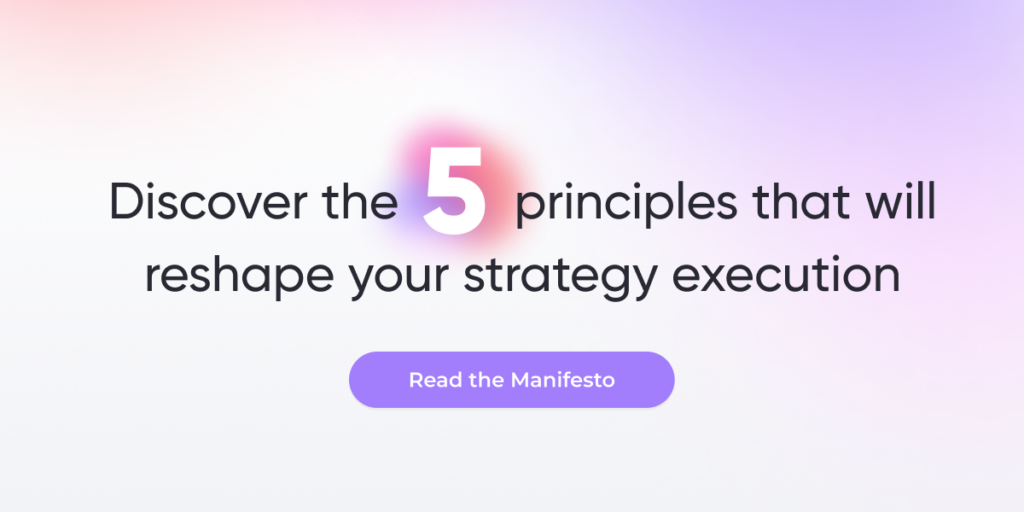
Employee engagement across different workforce types
Not every employee works the same way, and they definitely don’t get engaged the same way. The employee engagement strategy that works perfectly for your office-based marketing team might completely miss the mark with your remote developers or frontline retail workers.
Understanding these differences is crucial for supporting job satisfaction across your entire workforce and making sure your employee engagement strategy and efforts actually reach every employee
Remote and hybrid engagement strategies
Remote workers face a unique challenge: they can feel disconnected from company culture and left out of spontaneous engagement and interactions that build relationships. The solution isn’t trying to recreate the office experience virtually. It’s building new ways for employees to connect and contribute.
Make information accessible anytime, anywhere.
Remote employees shouldn’t have to wait for Monday’s team meeting to understand what happened in Friday’s leadership discussion. Create systems where people can catch up on company news, project updates, and team decisions on their own schedule.
Be intentional about inclusion in remote meetings.
It’s easy for remote participants to become passive observers while office-based colleagues dominate the conversation. Actively ask for input from remote team members, use collaboration tools that give everyone equal participation, and rotate who leads different parts of meetings to increase employee engagement.
Create virtual spaces for informal connection.
The casual conversations that happen naturally in offices don’t just happen over video calls. Set up dedicated chat channels for employee non-work discussions, virtual coffee breaks, or online interest groups where an employee can connect over shared hobbies or experiences for better engagement.
For hybrid workers, the biggest challenge is often feeling like they’re missing out on either the in-office energy or the remote flexibility, depending on where they are on any given day. Help employees feel connected to both experiences by ensuring important conversations happen on platforms everyone can access, not just in hallway conversations or impromptu desk visits.
Engaging frontline and deskless workers
Your frontline employees, whether they’re in retail stores, manufacturing facilities, healthcare settings, or field service roles, often get overlooked in employee engagement initiatives designed around email and computer access. These employees represent a huge portion of most companies’ workforce, yet they’re frequently the last to hear company news and the least likely to have input on decisions that affect their daily work.
Meet them where they are, not where it’s convenient for you.
If your frontline workers don’t sit at computers all day, don’t build your employee engagement strategy around desktop platforms and lengthy email updates. Use mobile-friendly communication tools, visual updates they can quickly scan during breaks, and audio or video messages they can consume while moving between tasks.
Recognize that their managers are often their primary connection to the broader company.
A store manager or shift supervisor has more influence on a frontline worker’s engagement than any corporate executive. Invest heavily in training these front-line managers to have meaningful conversations, recognize good work in the moment, and advocate for their employee with upper management.
Give them a voice in operational decisions.
Frontline employees often have the best insights into customer needs, process inefficiencies, and practical solutions, but they’re rarely asked for input. Create regular opportunities for them to share ideas and feedback, and more importantly, show them when their suggestions get implemented.
Multi-generational workforce considerations
A 22-year-old employee starting their first job has different motivations and communication preferences than a 45-year-old with two decades of experience or a 60-year-old planning for retirement. Trying to engage them all with the same approach usually means not effectively engaging any of them.
Younger employees often prioritize learning opportunities, mentorship, and understanding how their work connects to larger company goals. They want feedback frequently, not just during annual reviews, and they appreciate transparency about company direction and decision-making.
Mid-career employees are often focused on advancement opportunities, work-life balance, and having their expertise recognized and utilized. They want to see clear paths for growth and opportunities to take on leadership responsibilities or specialized roles.
Employees closer to retirement may be most engaged by opportunities to share their knowledge, contribute to training newer employees, and work on projects that feel meaningful and legacy-building. They often value stability and recognition for their years of contribution.
The key isn’t creating separate employee engagement programs for different age groups; it’s ensuring your overall employee engagement strategy includes elements that resonate with different career stages and life priorities.
Department-specific approaches
Sales teams are typically motivated by competition, recognition, and clear connections between effort and reward. They respond well to public acknowledgment of wins, opportunities to share best practices with peers, and understanding how each employee affects team and company success.
Engineering and technical teams often value autonomy, interesting challenges, and opportunities to learn new technologies or methodologies. They’re usually more motivated by solving complex problems and having input on technical decisions than by public recognition or competitive elements.
Customer service teams need to feel supported when dealing with difficult situations and empowered to actually help customers. They’re often most engaged when they see how their work improves customer experiences and when they have the tools and authority to resolve problems effectively.
Operations and administrative teams want to understand how their behind-the-scenes work enables the success of every employee. They’re often motivated by process improvements, efficiency gains, and recognition for the essential but less visible work they do.
Managing engagement during company transitions
Mergers, acquisitions, leadership changes, and major strategic shifts create anxiety and uncertainty that standard employee engagement approaches often can’t address. During these times, people need more communication, not less, and they need honesty about what’s changing and what’s staying the same.
Your employee engagement strategy should focus on what employees can control during periods when much feels uncertain. Help them understand their role in the transition, what success looks like for them personally, and how they can contribute to positive outcomes. Give them ways to influence the changes affecting them rather than just asking them to adapt to decisions made without their input.
Acknowledge that engagement might look different during transition periods. People may be more focused on job security and understanding new expectations than on optional programs or long-term development opportunities. That’s normal and temporary; don’t interpret it as failure of your employee engagement efforts.
The companies that maintain and improve employee engagement through major changes are the ones that treat their people like adults who can handle difficult information and contribute to positive work solutions.
Firstup allows us to make it happen
25 strategies for effective employee engagement
1. Employee engagement surveys and feedback systems
Stop guessing what your people actually think. Regular pulse surveys and feedback channels are foundational to any employee engagement strategy and give you real insights into what’s working and what’s driving people crazy. The key isn’t just asking questions, though. It’s actually doing something with the answers you get.
2. Peer-to-peer recognition programs
Sometimes the best recognition comes from the employee sitting next to you who knows exactly how hard that project was. Set up systems where employees can highlight each other’s wins, not just wait for management to notice.
3. Manager appreciation and leadership training
Your managers are either employee engagement strategy multipliers or killers. Invest in teaching them how to recognize good work, have meaningful conversations, and actually lead people instead of just managing tasks.
4. Flexible work arrangements
The 9-to-5, desk-bound workday is dead for many roles. Give people the flexibility to work when and where they’re most productive. Trust them to get the job done without micromanaging their location or schedule.
5. Professional development and skills training
People want to grow, not just do the same job forever. Offer learning opportunities that actually matter to their careers, whether that’s technical skills, leadership development, or industry certifications they can use.
6. Mentorship programs
Pair experienced employees with newer ones, but make it meaningful. This isn’t about coffee chats, though. It’s about real knowledge transfer, career guidance, and building relationships that help people succeed.
7. Internal mobility and career pathing
Show people where they can go within your company. Create clear paths for advancement and lateral moves so your best, highly engaged employees don’t have to leave to grow their careers.
8. Employee wellness programs
Burned-out employees aren’t engaged employees. Support their mental health, encourage fitness, and help them manage stress. Wellness isn’t a perk; it’s essential for any sustainable employee engagement strategy.
9. Transparent communication and company updates
Stop treating employees like they can’t handle the truth. Share what’s happening with the business, why decisions are being made, and how their work fits into the bigger picture.
When Lincoln Financial Group wanted to reach their multi-generational workforce more effectively, they consolidated various communication channels into a single digital platform that improved transparency and helped leadership connect with employees.
10. Team-building activities and social events
This isn’t about trust falls and icebreakers. Plan activities that actually help people get to know each other and work better together. Make it voluntary and make it fun.
11. Workplace autonomy and empowerment
Hire smart people, then let them do their jobs. Give an employee decision-making authority over their work environment, trust their judgment, and stop micromanaging every detail.
12. Fair compensation and benefits packages
Pay employees what they’re worth. If your compensation isn’t competitive, all the pizza parties in the world won’t increase employee engagement nor keep good employees from leaving for better opportunities.
13. Stay interviews and employee retention conversations
Don’t wait until an employee quits to find out why they’re unhappy. Have regular conversations about what’s keeping them engaged and what would make them consider leaving.
During Evergy’s major merger, they used two-way communication platforms to gather employee feedback and understand what people needed during the transition – exactly the kind of proactive listening that prevents good employees from walking out the door.
14. Goal-setting and performance management
Work with team members to set meaningful goals, not arbitrary metrics. Check in regularly, provide support when they need it, and recognize progress along the way.
15. Employee resource groups
Let people connect around shared interests, backgrounds, or experiences. These groups build community, support diversity, and give employees a voice in shaping company culture, making them valuable parts of your employee engagement strategy.
16. Innovation time and passion projects
Give people space to work on projects they’re excited about. Some of your best ideas and most engaged employees come from allowing creativity and personal interest to drive work.
17. Comprehensive onboarding programs
First impressions matter. Create an onboarding experience that helps a new employee feel welcomed, prepared, and excited about their decision to join your company.
Raising Cane’s built their “1LV Crew” platform as a central hub for training, news, and community engagement, making it easier to integrate new employees across their geographically dispersed team.
18. DEI initiatives and inclusive culture building
Build a workplace where every employee feels like they belong. Effective employee engagement strategy requires this foundation. This means more than diversity training; it’s about creating systems, policies, and cultures that support all employees.
19. Leadership visibility and involvement
Leaders who hide in their offices create disconnected workplaces. Get executives involved with employees at all levels, not just during crisis management or annual meetings.
Companies like Extreme Networks have made this easier by using digital platforms that enable direct communication from leadership and leadership videos for important updates, making executives more accessible to frontline employees.
20. Work-life balance support
Respect that your employees have lives outside of work. Create policies and expectations that allow people to be present for their families and personal commitments.
21. 360-degree feedback systems
Get feedback from multiple sources, not just top-down reviews. Let employees hear from peers, direct reports, and supervisors to get a complete picture of their performance and impact.
22. Technology and digital engagement tools
Give each employee modern tools that make their work easier, not harder. Invest in platforms that actually improve internal communication and collaboration instead of creating more complexity in your employee engagement strategy.
PVH Corp. solved this challenge for their non-wired retail associates with the “PVH Insider” app, while the American Cancer Society gave their field-based staff real-time access to critical information through a centralized communication platform.
23. Employee advisory committees
Create formal ways any employee to have input on company decisions. When employees feel heard and see their suggestions implemented, they become more invested in outcomes.
24. Exit interviews and offboarding processes
Learn from an employee who is leaving, and treat the departing employee well. They might come back someday, and they’ll definitely talk about their experience with others.
25. Personalized employee messaging (or 25 if you remove one of the above in red)
Different employees need different information at different times in their careers. Instead of blasting everyone with the same generic updates, tailor your communications to where each person is in their journey. Personalized messaging that speaks to their specific role, tenure, and career stage creates more meaningful connections than one-size-fits-all announcements. You can personalize employee experiences with journey automation in the Firstup platform to help deliver the right message to the right person at the right time.
Each employee engagement strategy addresses what employees actually care about: feeling valued, having growth opportunities, and a work environment where they can succeed.
Deliver a hyper-personalized employee experience at scale
How to measure employee engagement success
You can’t improve what you don’t measure, but most companies are tracking the wrong things when trying to increase employee engagement levels. Satisfaction scores and simple annual surveys might make it seem like you’re doing something, but they won’t tell you if your efforts are actually working or exactly how your employees feel.
Real measurement for any employee engagement strategy means looking at behaviors, not just opinions. It means tracking changes over time, not just taking snapshots. And it means connecting employee engagement levels to business outcomes so you can show leadership that this work actually matters.
Key metrics that actually matter (beyond satisfaction scores)
Forget about asking how employees feel on a scale of 1 to 10. Here are the metrics that reveal what’s really happening with employee engagement:
Employee retention rates by department and role. If people are leaving your sales team but staying in customer service, that tells you something specific about where engagement is breaking down. Track voluntary employee turnover separately from layoffs or performance-related exits.
Internal referral rates. Engaged employees recommend your company to their friends. If referrals are dropping, it’s often an early warning sign that something’s shifting in how people feel about working there.
Participation rates in optional programs. How many people actually show up to town halls, join employee resource groups, or sign up for professional development? Engaged employees opt in. Disengaged ones do the minimum required.
Time to fill open positions. When you have high employee engagement, word gets around that your company is a good place to work. Recruiting becomes easier, and you spend less time convincing people to join.
Manager effectiveness scores. Since managers have the biggest impact on engagement, track how well they’re doing. Look at employee retention rates on their teams, feedback from direct reports, and whether they’re actually having the conversations that matter.
Cross-department collaboration metrics. Engaged employees are more likely to work well with other teams, share information, and contribute to projects outside their immediate role. Track how often this happens naturally.
Setting realistic benchmarks and timelines
Most employee engagement strategy initiatives fail because companies expect to see dramatic changes in a work environment. Real cultural change takes time, and your expectations need to reflect that reality.
Start with baseline measurements. Before you launch any new action plan, document where you are right now. What’s your current employee turnover rate? How many people participate in optional programs? What do exit interviews reveal? You can’t measure progress without knowing your starting point.
Set different timelines for different outcomes. Some changes happen quickly; people might start participating more in team meetings within a few weeks. Others take months or years: building trust with leadership, changing deeply ingrained cultural patterns, or seeing significant shifts in retention rates.
Benchmark against yourself, not just industry averages. Industry benchmarks can give you context, but what matters most for your employee engagement strategy is whether you’re improving. A 15% employee turnover rate might be excellent for one industry and terrible for another.
Expect some metrics to get worse before they get better. When you start measuring employee engagement more carefully or asking for more honest feedback, you might uncover problems you didn’t know existed. That’s not failure; that’s progress toward understanding what you’re actually dealing with.
Using data to refine your approach
Data without action is just expensive record-keeping. The point of measuring engagement is to learn what’s working in your employee engagement strategy and what needs to change.
Look for patterns, not just numbers. If employee turnover is high in one department but low in others, dig into what that department’s manager is doing differently. If participation drops after certain types of events, figure out why people aren’t showing up.
Connect employee engagement data to business outcomes. Which teams with high engagement scores also have high customer satisfaction ratings? Are engaged employees more likely to contribute ideas that actually get implemented? Make those connections visible to leadership.
Test small changes and measure the impact. Don’t overhaul your entire employee engagement strategy at once. Try one new approach with one team, track what happens, then decide whether to expand it. This way, you learn what actually works in your specific environment.
Ask follow-up questions when something surprises you. If an employee engagement survey shows people are frustrated with communication, don’t just assume you need more meetings. Talk to employees about what kind of communication they actually want and when they want it.
ROI of engagement initiatives
Leadership wants to know that employee engagement strategy efforts are worth the investment. Here’s how to make that case with real numbers:
Calculate the cost of disengagement. Add up what you’re spending on recruiting, training new hires, overtime to cover for vacant positions, and lost productivity during transitions. Then factor in the revenue impact of slower project completion and lower customer satisfaction scores.
Track the financial impact of improvement. When employee retention improves, recruiting costs go down. When employee engagement goes up, productivity often follows. When people feel more connected to their work, customer scores typically improve. Document these connections.
Measure efficiency gains. Engaged employees often find better ways to do their work, need less supervision, and require fewer do-overs. These efficiency improvements add up to real cost savings, even if they’re harder to quantify than turnover.
Consider the cost of not investing. What happens to your business if employee engagement continues to decline? How much would it cost to replace half your workforce? How would that disrupt customer relationships and project timelines? Sometimes the ROI case is about avoiding catastrophic costs, not just generating new revenue.
The goal isn’t to turn employee engagement into a spreadsheet exercise. It’s to understand whether your efforts are making a real difference in how people experience work and whether that difference matters to your business.
Getting started: Your first 90 day action plan
The first three months of any employee engagement strategy are all about building momentum and trust. Start by setting a simple, step-by-step plan. Begin with honest conversations or a short employee engagement survey to find out what’s working and where people feel stuck. Listen for patterns and look for opportunities to deliver a few quick wins. Maybe it’s more regular communication, better performance management, public recognition, or easier ways to share feedback.
Don’t try to tackle everything at once. Pick one or two areas in an engagement strategy where you can make an immediate impact, and let your team see progress early on. Celebrate those small wins openly, and share updates so everyone knows what’s changing and why. Meanwhile, outline a few bigger goals for the future, and use what you learn in these first weeks to shape your long-term employee engagement strategy approach.
How Firstup makes having engaged employees easier
Firstup gives you the tools to put your employee engagement strategy into motion and keep everyone aligned from day one. With workforce orchestration at its core, the platform brings all your communications, feedback, and recognition programs into one place so it’s easy to reach every employee and ensure nothing slips through the cracks. Whether you’re sharing updates, gathering input, or celebrating early wins, Firstup helps you organize, automate, and personalize your approach.
Are you ready to improve employee engagement at your organization?
Download PDF
